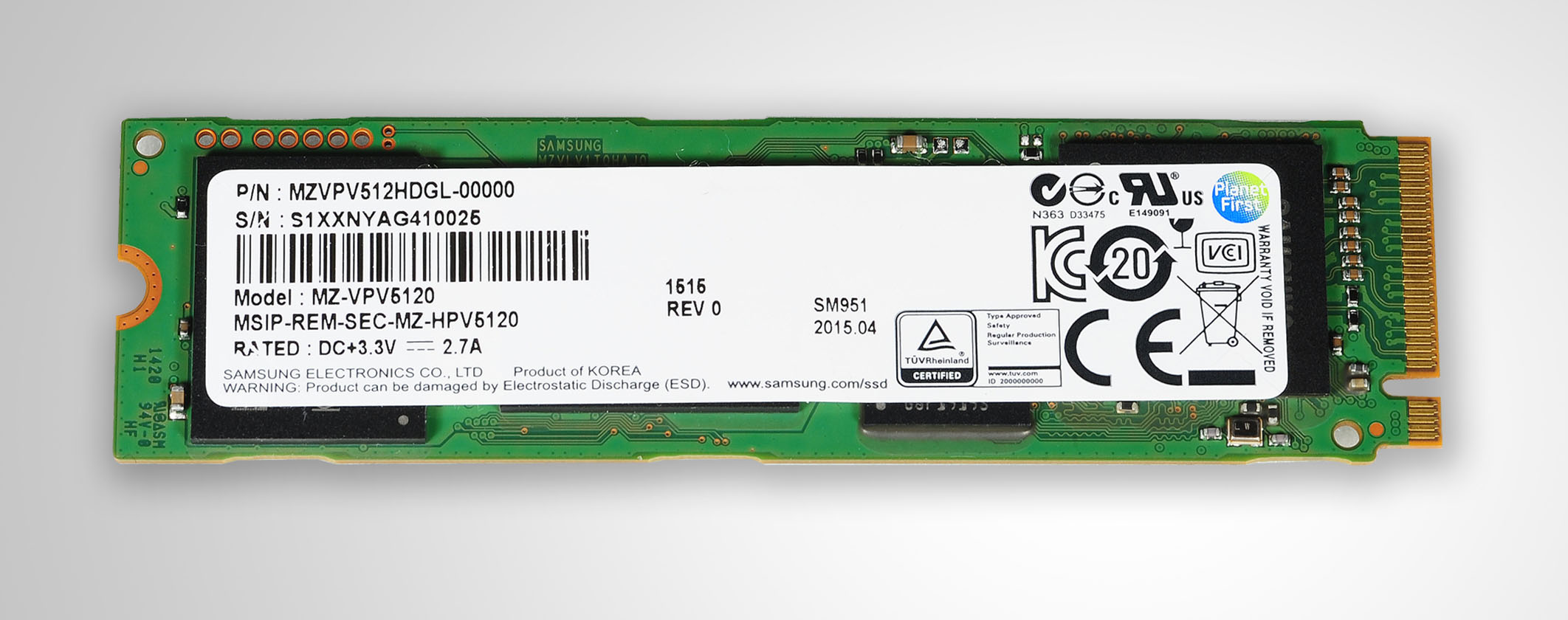Samsung Announces SM951-NVMe PCIe SSD; 3D V-NAND Version May Come This Summer
In July 2014, Samsung stated the company will release the first consumer NVMe SSD. The first SM951 arrived with the AHCI command set in the Lenovo X1 Carbon Gen 3 Ultrabook just after CES 2015. The X1 Carbon Gen 3 SM951 is a Lenovo-specific model with lower sequential read performance than what Samsung stated in the specification documents in order to save power and reduce thermal load. RamCity started shipping SM951 AHCI models that meet the full 2,150 MB/s sequential read performance just last week.
The AHCI model release allowed Intel time to bring the SSD 750 NVMe to market before Samsung, thus taking the first-to-market crown. We recently published our SSD 750 1.2 TB review and found the AHCI SM951 comparable under client workloads. The SSD 750 with native NVMe is quite a bit faster under workstation workloads where the queue depth increases.
Recently, Samsung fired back with the SM951-NVMe. The updated model with NVMe technology boasts slightly higher sequential performance over the AHCI command set SM951 and significantly higher random performance. Samsung claimed sequential read performance of 2,160 MB/s and sequential write performance of 1,600 MB/s. The largest performance gains come in the random read category. The AHCI model delivers just over 130,000 random read IOPS, but the new SM951-NVMe is rated at 300,000 IOPS. Samsung didn't state what queue depth the SM951-NVMe achieves, but we suspect the new model needs high queue depths to reach that level of performance.
Unfortunately, the SM951-NVMe is still limited to a maximum density of 512 GB, just as the AHCI model was. Both use 1xnm 2D planar multi-level cell (MLC) NAND instead of Samsung's advanced 3D V-NAND technology, which vertically stacks storage cells 32 layers high. However, Samsung understands the current demand for high capacity models and made it clear future models will move to 3D V-NAND to increase capacity.
"In the future, Samsung plans to incorporate its next-generation 3D V-NAND technology into its NVMe SSD line-ups, which will enable even higher densities and performance. Samsung also will maintain a fast-to-market supply of advanced SSDs to meet increasing customer demand, as the company continues to lead the premium SSD market and aggressively innovates to expand the mainstream SSD segment," read the press release.
The SM951 comes from Samsung's SSI group, which supplies products to OEM customers for pre-built computers and other products. In the past, Samsung announced new retail flagship products in July, just a month after Computex at the Samsung SSD Global Summit. This is an annual event held in Seoul, South Korea for media. In 2014, the company hinted at consumer PCIe products as the future for enthusiast performance products. We suspect Samsung will release a mass production retail PCIe-NVMe product at this year's event with 3D V-NAND technology.
PCIe 3.0 x4 allows for up to 32 Gb/s (8 GB/s) of bi-directional transfer performance. This gives SSD manufacturers room to improve PCIe-based product performance for several generations.
Get Tom's Hardware's best news and in-depth reviews, straight to your inbox.
Follow us @tomshardware, on Facebook and on Google+.

Chris Ramseyer was a senior contributing editor for Tom's Hardware. He tested and reviewed consumer storage.
-
sc14s ReplyThis SSD doesn't support hardware encryption.
You do realize this type of SSD would be going into lower wattage devices correct? Encrypting those devices will likely slow them down immensely if it doesn't have specialized hardware for it. A good example would be try to encrypt an android phone. The vast majority of them do not have the requisite hardware encryption so end up slowing the hell out of your device. -
heisenberg01 --- "PCIe 3.0 x4 allows for up to 32 Gb/s (8 GB/s)" ---Reply
Which is it? 32Gb == 4GB. 64Gb == 8GB... -
WyomingKnott This is what's going to push me to finally build a new machine - NVMe drives with adequate PCIE channels. Whether it's m2 or a card in a slot.Reply -
crazy1 NVMe and 3D V-NAND in a M.2 form factor is what I expected the SM951 to be when it was first released earlier this year. Now, it's not coming until later this year. Samsung seems to be milking their lead in the market with both M.2 devices and 3D NAND chips. I guess they couldn't just put all their SSD technologies together in one device and leave no room for growth. Hopefully, they finally have it all integrated in one SSD by the release of Skylake and Windows 10. And don't forget the hardware encryption.Reply -
lahma ReplyThis SSD doesn't support hardware encryption.
You do realize this type of SSD would be going into lower wattage devices correct? Encrypting those devices will likely slow them down immensely if it doesn't have specialized hardware for it. A good example would be try to encrypt an android phone. The vast majority of them do not have the requisite hardware encryption so end up slowing the hell out of your device.
The SED hardware encryption found on SSDs (such as OPAL 2.0). All of the encryption is handled by a dedicated controller on the SSD itself and is transparent to the OS. It requires no additional CPU cycles for encryption/decryption and has virtually no impact on battery life.
-
mikeangs2004 Reply
That's "not right" substituted by moderator, like previous post stated.This SSD doesn't support hardware encryption.
You do realize this type of SSD would be going into lower wattage devices correct? Encrypting those devices will likely slow them down immensely if it doesn't have specialized hardware for it. A good example would be try to encrypt an android phone. The vast majority of them do not have the requisite hardware encryption so end up slowing the hell out of your device.
